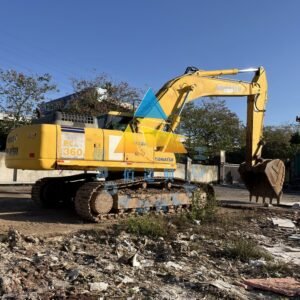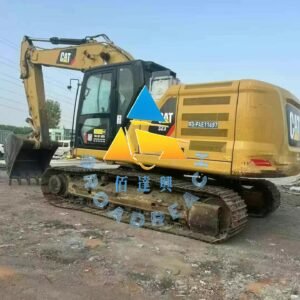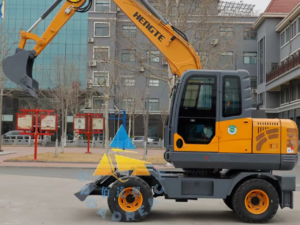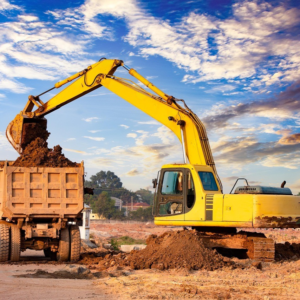BroadReach Construction Machinery Co., Ltd

Are Used Excavators Cheaper Overseas?
Thinking about scoring a Second-hand excavator machine from overseas to save cash? Hold your horses—let’s break down whether that “cheap” price is actually a steal or a sneaky trap.
The Allure of Overseas Deals
Picture this: You’re scrolling through an overseas auction site and spot a used excavator listed for $20,000 less than similar models in the US. Tempting, right? But before you grab your passport and start wiring cash, let’s get real—buying a used excavator from overseas comes with a whole lot of fine print. Here’s the lowdown on whether those “cheap” prices are actually a steal or a setup for disaster.
Why Overseas Used Excavators Might Look Cheaper
1. Market Dynamics & Equipment Turnover
In countries like Japan or Germany, construction equipment gets replaced more frequently, so used machines with low hours hit the market faster. For example, a 5-year-old Japanese used excavator might cost 30% less than a similar US model. Why? Companies there often upgrade to newer tech every few years, flooding the used market with well-maintained machines.
2. Currency Exchange & Auction Markets
When the US dollar is strong against local currencies (like the yen or euro), overseas prices can look extra appealing. A dip in the euro-to-dollar exchange rate, for instance, might make a German used excavator suddenly 15% cheaper in USD. Plus, international auction sites like Ritchie Bros. or local Japanese platforms list used excavators at starting bids that undercut US dealers.
3. Model Availability & Niche Markets
Some used excavator models are more popular overseas, making them cheaper to buy used. Compact excavators, for example, are huge in Japan but less common in the US—so you might find a rare, low-hour compact model overseas for a fraction of the US price. Niche brands or specialized machines (like mini-excavators for urban construction) also tend to have better availability overseas.
The Real Reason “Cheap” Often Isn’t
1. Shipping, Duties, & Customs Fees
Shipping a used excavator from Japan to the US can cost $5,000 to $15,000—yes, that’s on top of the purchase price. Add customs duties (up to 2.5% of the machine’s value) and import taxes, and your “cheap” machine just got $10,000 more expensive. Even shipping from Canada or Mexico can rack up fees like border processing and brokerage costs.
2. Emissions & Safety Certifications
US EPA and DOT regulations can be a headache for overseas used excavators. A European machine might need $2,000 to $5,000 in emissions upgrades to meet US standards. Older models might even fail safety inspections, requiring costly modifications to lights, mirrors, or exhaust systems.
3. Parts, Service, & Language Barriers
Overseas used excavators—especially non-US brands—can be a nightmare for parts. A hydraulic hose for a Japanese-model Komatsu might only be available from overseas suppliers, costing twice as much and taking weeks to arrive. Plus, service manuals and diagnostic tools might be in Japanese or German, making repairs a headache unless you have a multilingual mechanic.
When Overseas Is Worth It
Ⅰ. DO Buy Overseas If
- You’re Working with a Reputable Exporter: Companies like Yusen or Kato Works specialize in shipping used excavators to the US, handling customs and certifications for you. They’ll provide inspection reports and even offer limited warranties.
- You Need a Niche Model: If you’re searching for a compact used excavator or a specialized attachment that’s rare in the US, overseas markets might be your only shot. Just budget for extra costs upfront.
- You Have a Trusted Mechanic: If you’ve got a mechanic who’s experienced with imported equipment (or you’re handy enough to DIY), overseas models can work. They can source parts from international suppliers or modify components as needed.
Ⅱ. DON’T Buy Overseas If
- You’re on a Tight Budget: Hidden costs like shipping and certifications can blow up your budget. If you can’t afford to spend 20-30% more than the purchase price, stick to local buys.
- You Need the Machine ASAP: Shipping and customs clearance take 4-8 weeks, minimum. If your job starts next month, an overseas used excavator will leave you high and dry.
- You’re New to Buying Used Equipment: Importing involves complex paperwork and inspections. If you’ve never bought a used excavator before, start local—learn the ropes before diving into international purchases.
Pro Tips for Overseas Buyers
Ⅰ. Inspect Before You Pay (Like, Actually Inspect)
Hire a local inspector—services like SGS can send someone to check the used excavator in person before you pay. They’ll look for hidden damage, verify hours, and test mechanical functions. Photos and videos lie; a physical inspection is non-negotiable.
Ⅱ. Calculate Total Cost (Including the Small Print)
Use a shipping calculator (like Freightos) to estimate delivery costs, then add customs duties, taxes, and any required modifications. Plug these numbers into your budget before comparing prices—you might find a “cheaper” overseas model is pricier than a local one.
Ⅲ. Stick to Well-Known Brands
Brands like Komatsu, Caterpillar, and Volvo have global parts networks. Avoid obscure brands or models that aren’t sold in the US—you’ll regret it when you need a replacement part. Even with popular brands, research parts availability in the US before buying.
The Truth About Overseas Used Excavators
So, are used excavators cheaper overseas? Sometimes—but only if you’re willing to navigate shipping hassles, handle import red tape, and budget for hidden costs. For most buyers, especially those new to used equipment, sticking to local sellers is safer. They offer warranties, quick parts access, and easier inspections—peace of mind that’s worth the extra dough.
But if you’re an experienced buyer with a specific need, a reputable exporter, and a solid budget, overseas markets can yield great deals. Just remember: do your homework, calculate every cost, and never assume “cheap” online prices tell the whole story.






